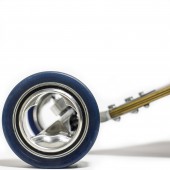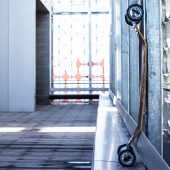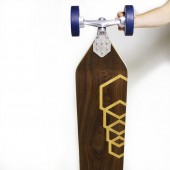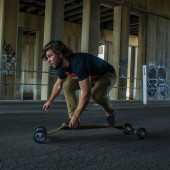
| THE AWARD |
| CATEGORIES |
| REGISTRATION |
| SUBMIT YOUR WORK |
| ENTRY INSTRUCTIONS |
| TERMS & CONDITIONS |
| PUBLICATIONS |
| DATES & FEES |
| METHODOLOGY |
| CONTACT |
| WINNERS |
| PRESS ROOM |
| GET INVOLVED |
| DESIGN PRIZE |
| DESIGN STORE |
| THE AWARD | JURY | CATEGORIES | REGISTRATION | PRESS | WINNERS | PUBLICATIONS | ENTRY INSTRUCTIONS |
Zenyth Hubless Longboard by Nicholas Perillo |
Home > Winners > Design #42071 >Interview |
 |
|
FS: What is the main principle, idea and inspiration behind your design?
NP: This design was for an advanced prototyping class at university. I was not restricted by a design brief as such, so i could have some fun. The main objective was to explore prototyping processes that I hadn't had much, or any experience with before, to create a resolved product before the end of semester. I had been talking to a friend about his new longboard and playing around with hub less wheels on some car sketches for fun. I thought, why not both? And the idea was born.
FS: What has been your main focus in designing this work? Especially what did you want to achieve?
NP: I really wanted to challenge myself to make a high quality and functioning product. It also had to look great, so a standard skateboard design wasn't going to cut it. I wanted the whole form to flow seamlessly and cast an almost impossible shilouette. When I proposed my idea people had their doubts on weather it was possible so i had to prove them wrong.
FS: What are your future plans for this award winning design?
NP: I have had thoughts of improving the design and producing a limited run of these boards. But it would be a huge process that would distract from my current study. It is of course still an option later on if interest is high enough.
FS: How long did it take you to design this particular concept?
NP: The initial design was really fast. I didn't have time to make any mockups or much testing so I jumped from sketches to machine ready CAD files within 3 weeks and tweaked things as the build progressed. I had to get it all done for the end of semester exhibition while also working on other studio work. The whole board from concept to final product was completed in 13 weeks among other projects.
FS: Why did you design this particular concept? Was this design commissioned or did you decide to pursuit an inspiration?
NP: This was me having fun with the facilities I had at my disposal and a crazy idea. I had presented three concepts initially and this was the most challenging, thats why I chose it.
FS: Is your design being produced or used by another company, or do you plan to sell or lease the production rights or do you intent to produce your work yourself?
NP: This is all still up in the air. It may end up being a one off piece.
FS: What made you design this particular type of work?
NP: Being free to design whatever I wanted while challenging my prototyping skills.
FS: Who is the target customer for his design?
NP: Anyone who wants to be the centre of attention when rolling down the street. This thing turns heads and baffles people!
FS: What sets this design apart from other similar or resembling concepts?
NP: I think you would be hard pressed to find many similar or resembling concepts. It has a form factor unlike any other longboard or skateboard made before. most skateboards have a deck that dips down and the trucks are mounted underneath. This board rises and the trucks mount on the tips of the board. Its bonkers!
FS: How did you come up with the name for this design? What does it mean?
NP: The word zenith means, the highest point reached by a celestial or other object. I changed the spelling to Zenyth as a point of difference and I felt this worked well with the rising, arched deck and the overall sci-fi feel of the design.
FS: Which design tools did you use when you were working on this project?
NP: A mixture of hand sketching, Solidworks modelling, Adobe programs and rapid prototyping.
FS: What is the most unique aspect of your design?
NP: Its beautiful form and of course the hub-less wheels.
FS: Who did you collaborate with for this design? Did you work with people with technical / specialized skills?
NP: In the workshop at RMIT I had the help and advice of some very experienced technicians who where integral to realising this project.
FS: What is the role of technology in this particular design?
NP: Without 3D design tools and rapid prototyping methods this design wouldn't exist. I was able to test strength and make assemblies very quickly and cheaply.
FS: What are some of the challenges you faced during the design/realization of your concept?
NP: Time was the biggest challenge. I was constantly against the clock managing other work and assignments during the semester. As with any project, things go wrong and take time to work around. One of the other challenges was making the whole thing work without any other prototyping. Because of the time constraints I only had one shot at everything, so it all had to be very well considered. This had to be the first and final prototype.
FS: How did you decide to submit your design to an international design competition?
NP: I have received more attention on it than anticipated so I thought I might as well go for it.
FS: What did you learn or how did you improve yourself during the designing of this work?
NP: I have learnt a lot through this project. Mainly about rapid prototyping and all the factors that need to be considered, to fully realise a product.
FS: Thank you for providing us with this opportunity to interview you.
A' Design Award and Competitions grants rights to press members and bloggers to use parts of this interview. This interview is provided as it is; DesignPRWire and A' Design Award and Competitions cannot be held responsible for the answers given by participating designers.
| SOCIAL |
| + Add to Likes / Favorites | Send to My Email | Comment | View Press-Release |





